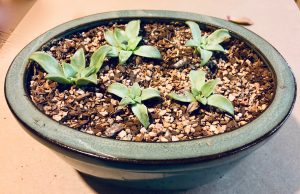How to Grow Succulents from Leaves
By Mary Francis, Fairfax Master Gardener Intern

Succulent leaf taking root
Winter arrived as it always does. After record-setting rains during the outdoor garden season, I felt the need to garden indoors. Succulents came to mind. Many stores had stocked succulents for the holidays, with a remarkable variety of forms, shapes and colors. I was inspired to buy leaves which I found on the internet.
Knowing these plants dislike too much water, I used four different types of soil. I tried a regular potting soil container mix and a cactus and succulent mix. Both are readily available commercially. I used cocopeat alone. Cocopeat, made from shredded coconut hulls, is available as compressed blocks that greatly expand with water. I also tried a mixture of regular container mix potting soil with vermiculite and cocopeat, all in equal proportions.
At first, I thought I would need to dip the bottom of the leaves in rooting hormone and create a greenhouse environment by planting them in plastic bags. I used regular container mix potting soil. Rooting was successful, with few casualties. Moss grew on the top of the soil but seemed to have little to no adverse effect.
I bought many different leaves and tired-looking succulents. I looked to simplify the rooting process. A double fluorescent light with no particular characteristics was chosen as my light source. It was located in a heated area of the house. Plastic and aluminum trays, some with drainage and some without, were filled to 2 inches deep with the different soils. I poked some of the leaves into the soil, and others I put on top of the soil. I watered the trays gently and lightly with warm water and a watering can with a shower head. Then they were placed under the light. After a week, they were bone dry, so I watered them again in the same way as before. About four days later, I sprayed them well with a spritzer. With time, I found using the spritzer alone was not enough and resorted to the watering can once per week.
The most difficult part of the process was waiting for the plants to root. The first roots appeared after four weeks. By that time, I lost 15 leaves out of more than 100 planted. In the spring, several weeks after the last frost, the leaves went outside and gradually acclimated to the outside conditions. Here I learned that shelter from rain was important. The leaves were too fragile at first to withstand it. If the containers had drainage holes, watering was simplified, as a garden hose with a sprinkler can be used instead of hand watering. In about a month, they were transplanted into pots in groupings. I used a potting mix for containers, mixed with cocopeat and vermiculite. I also fertilized them at this time with a cactus and succulent formulation. They grew into attractive succulent arrangements. In fall before frost, the plants were brought indoors and placed under artificial lighting for the winter

Succulent plant at 4 months
Succulents are easily rooted from single leaves. The biggest challenge is controlling the amount of water the leaves receive so they will not be too wet. Overwatering can rot the leaves, especially because it leads to problems with fungi that cause rot. If you have doubt, using less water is desirable.
There is a preferred method to harvest leaves from a succulent plant. Leaves located on the lower part of the plant should be selected. They should be rocked side to side gently until the entire leaf comes free. One should see a clean break. The leaves should be placed in bright indoor light with no water added. Tissue paper works well for this step. It is important to wait to ensure the formation of a callus at the base of the leaf so rooting will occur. Callus cells are those that develop to cover a plant wound.
Rooting succulents from leaves is an inexpensive, easy and entertaining way to build a collection of slow-growing plants that require little space or care. This is an easy and satisfying exercise for those who want to explore propagation beyond planting seeds.
Resources
• Secrets to success when propagating succulent plants, Gretchen Voyle, Michigan State
University Extension
• Propagation—Succulents and woody plants, T. Eric Nightingale, University of California Napa Master
Gardeners, September 2017